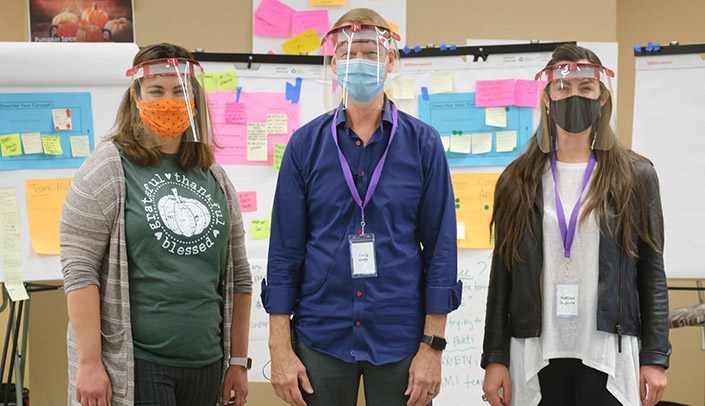Nurturing innovative ideas can be as simple as saying “yes, and. . .”
The open-ended “yes, and” statement — as opposed to “no, but” thinking — helps build on ideas presented, said Kathryn Segovia, PhD, director of the design thinking program at Stanford. “Looking through a new frame provokes ideas and new thinking.”
Consider when a colleague tosses out an idea. How one responds either helps or hinders the creative problem-solving process. “What if we do X, Y and Z?” someone says. Using a “yes, and then what if we do ABC . . . ” response is more likely to lead to additional — perhaps even bold — ideas that can be vetted later.
Dr. Segovia, who grew up on a Nebraska farm before studying and working at Stanford, helped lead a three-day workshop on campus to help UNMC incorporate design thinking into its DNA. On Oct. 27, as part of UNMC’s virtual Breakthrough Thinking Conference series, she shared how design thinking can inspire and lead groups through uncertainty in education.
She was joined by Douglas Dietz, principal design thinker for GE Healthcare in Waukesha, Wisconsin, who shared innovative case studies that exemplified the design thinking process and specifically focusing on GE Healthcare technologies for preemies in the NICU.
View the recording of this event.
The Breakthrough Thinking Conference series continues on Nov. 23 with J. Nwando Olayiwola, MD, and Ruth Shim, MD, who will speak on inclusion and diversity. Two additional events are planned for the spring.
So, what is design thinking? A methodology for empathy-based problem solving, design thinking is a non-linear, iterative process to tackle problems that involves five phases — empathize, define, ideate, prototype and test.
Dietz acknowledged that many iterations of a design are needed and it’s OK to “fail early, fail cheap,” to reach the decision that best solves the problem at hand. “It’s always important to remember why you are doing what you are doing,” he said.
Diversity of thought is critical to the process, he said, and requires a team of experts and non-experts, all of whom are focused, empathetic and committed to solving the problem at hand. Differing viewpoints helps teams better see — and solve — the problem at hand. As a result, he has, at times, challenged his team to approach a problem as if they worked at Disney or Amazon, and not GE Healthcare.
The design thinking process is effective, he said.
“The magic happens at the intersection of ‘yes, and . . . ‘ ,” he said.
